Trending
Opinion: How will Project 2025 impact game developers?
The Heritage Foundation's manifesto for the possible next administration could do great harm to many, including large portions of the game development community.

Featured Blog | This community-written post highlights the best of what the game industry has to offer. Read more like it on the Game Developer Blogs or learn how to Submit Your Own Blog Post
We released Toto Temple Deluxe on PS4, Xbox One, Wii U and Steam on September 29th 2015. The game didn’t sell very well, and we think we know why.


In May 2013, we attended TOJam and made a local-multiplayer game called Toto Temple. About a year later, we released a first version called Toto Temple Deluxe on Ouya. We kept improving the game afterwards and released the final version of Toto Temple Deluxe on PS4, Xbox One, Wii U and Steam on September 29th 2015. The game didn’t sell very well, and we think we know why.
Let’s not waste your time, we both know that’s what you want to see ;) As I’m writing this update, the game has been out for 4 months (released on Sept.29th 2015). Here’s how close we are from breaking even:

We sold around 6k copies in total, which is really not a lot, as you can see. Maybe we’ll benefit from the long tail eventually, or even better, the stegosaurus tail!
The truth is, we never actually planned to do anything with Toto Temple (the jam version). We were presented with a chain of opportunities, and we simply decided to take each one of them as the development went on.
The first opportunity we took after the Toronto Game Jam (where the game ended up being one of the favorites), was taking Ouya’s money to make a full fledged game out of Toto Temple. At the time, Matt Thorson’s Towerfall was Ouya’s killer app, and they wanted to cash in on that local-multiplayer trend (who wouldn’t). We took the money and made a bigger version of the game, which we then called Toto Temple Deluxe.
The deal was simple, get a bigger game (and more experience) in our portfolio without spending our own money. The game went live on Ouya, people enjoyed the Deluxe version, we even received really nice feedback from the press at E3 (Ouya booth).
Here we were, a couple weeks after the Ouya release, with a “console friendly” game in our hands, which technically didn’t cost us anything to make. For us, this was something unusual: we used to make small Flash / mobile games, and we now had a “big” game that could be played in the living room with actual controllers. It felt like a big deal, as we could remember actually saying a couple years ago that “we would probably never be able to make console games”. At the time, we didn’t have the skills to develop for consoles, and Unity wasn’t really a thing yet.
This is where we took the opportunity to get in touch with the 3 giants. We arranged meetings at GDC and pitched Toto Temple Deluxe to the 3 console owners. They all liked the game and things moved forward pretty quickly after that. We officially became PS4, Xbox One and Wii U developers, which still felt like a really big deal. We were in the big leagues now.
Being total beginners in the console market, we quickly realized that we would never get an interesting exclusivity deal with any of 3 console owners, since the game was already out on Ouya.
Knowing that, we decided to release the game on all 3 consoles. The decision was mainly based on 2 points:
Our thought process back then was that if we can’t strike a good exclusivity deal, then let’s do all 3 consoles for 3 times the revenue.
We also thought that we probably wouldn’t get the media’s attention 3 times for the same game (the 3 releases), so let’s release the game on all 3 consoles at the same time. That way, we would get decent attention one time and speak to all console owners at once.
We genuinely think Toto Temple Deluxe is a lot of fun, under the right circumstances. We designed the game to be as family friendly as possible, meaning that anyone should have a minimum amount of fun, no matter how skilled their opponents are (auto-balance system, etc). It’s also designed to be played with real people, in the same room, on the same couch. The more yelling, the better!
We also witnessed genuine fun and engagement from players who tried the game in public events, like PAX and Comiccon (see the engagement below).
We don’t think the game didn’t sell well because it wasn’t fun. On the other hand, Toto Temple Deluxe is still quite different from those other popular local-multiplayer games.
One of the first thing you notice when you first play Toto Temple Deluxe is how tricky it can be to effectively move around in the game (by using the dash mechanic). Even if we did our best to explain the controls in the most intuitive way we could think of, there’s still a difficulty curve that you need to overcome to really feel at ease while moving around.
It definitely comes in the way of our goal to make the game family friendly. We should either have made the controls simpler, or aimed at a more “experienced” crowd from the start. Not both. In Towerfall, for instance, everyone can be deadly by simply pressing the “shoot” button once. It’s that simple. In Toto Temple Deluxe, you need to:
Get close to the goat carrier
Use a combination of 2 buttons to dash towards the goat carrier
Hope that you were aiming right
If not, you need to turn around and start over
It’s definitely not a problem once you get the hang of it, but it’s not making the game as easy to get into for new players.
Tricky controls can actually be a good thing if they’re funny to watch. Our friends from Breakfall did just that with their game Starwhal. The game is pretty hard to control, but it’s part of the show, as you watch your starwhal wiggle its way towards your opponent's heart.
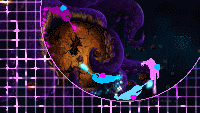
In Toto Temple Deluxe, it’s actually pretty hard to make sense of what’s happening on the screen if you don’t know the game already. I mean, look at this:
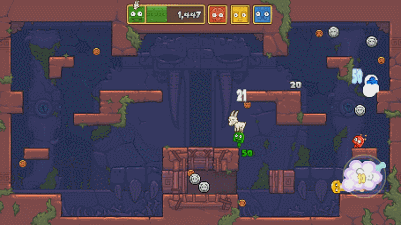
Toto Temple Deluxe doesn’t really give a “good show” by default. You never see spectacular kills like in Towerfall or Starwhal, and not many actions are worth their own replay / slow motion sequence (there are, but they’re harder to spot). It’s not making the game less fun to play, obviously, but it’s making it less fun to watch. It might not be that attractive to YouTubers and Twitchers for this reason.
In most competitive local-multiplayer games where you can “eliminate” players in some way (Samurai Gunn, Nidhogg, Towerfall, Starwhal, etc), you often find significant variations in intensity.
The tension goes up as you’re fighting / trying to survive, but once you or the other player is eliminated, there’s this drop in intensity that lets you breath (and celebrate) for a couple seconds, which feels right. On paper, it would probably look like this:
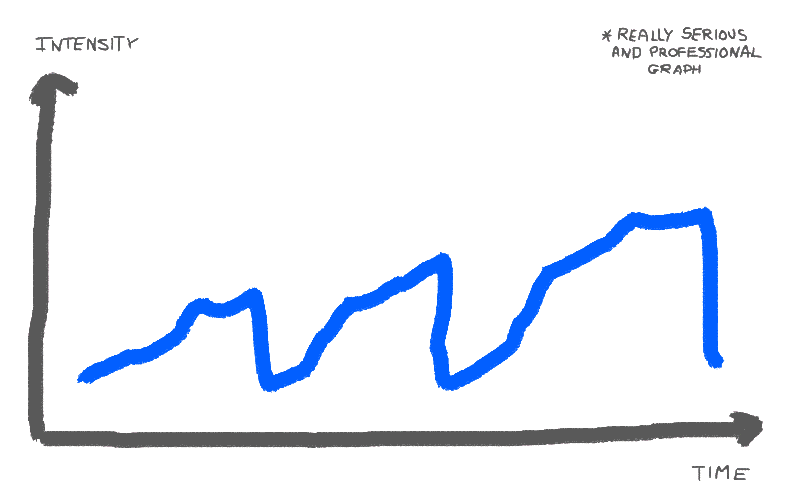
In Toto Temple Deluxe, the intensity graph probably looks more like this:
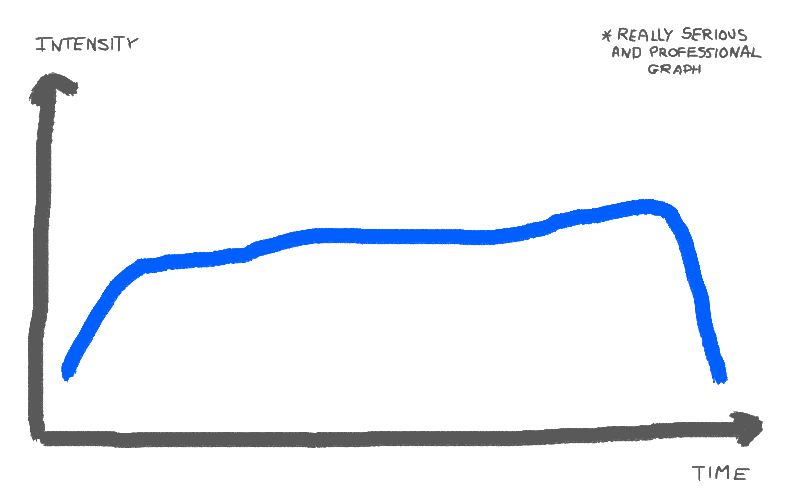
You get micro rewards / satisfactions every time you steal the goat or strike a power-up, but the game doesn’t stop nor celebrate it that much, it just keeps going. Your real reward is at the end, when you finally reach 3k points and win the match.
We don’t think this kind of intensity is necessarily a bad thing, but it forced us to reduce the time of a match to about 2 minutes maximum. Anything passed that would really drain you out mentally, and a single game was usually more than enough.
All of these elements are probably not responsible for the game not selling well, but they do have an effect on the actual feel and accessibility of the game.
Following the release of the article, we received a lot of feedback regarding the general theme and title of the game. Here’s an update on this particular subject.
A big huge part of selling copies of your game is to grab people’s attention when they first encounter your game on website or in a store. You do that by having a good looking game (originality, style, theme, etc), which comes up in screenshots and trailers. You also need to have a good title that is both memorable/catchy and describes the game well. Finally, your game’s description (elevator pitch) also needs to let people wanting more, or at least generate some kind of wonder in their mind.
We didn’t have any of this in Toto Temple Deluxe.
The Mayan / temple theme wasn’t bad, but it wasn’t good either. It’s clearly overused, uninspired and doesn’t make you want to discover the game’s universe because you already know what that kind of universe looks like. Don’t get me wrong though, I think our game is beautifully drawn. We’re solely talking about theme here.
The main reason for all of this is because we chose the theme during the initial game jam. It was nicely supporting our first prototype about little servants defending the treasures in a temple for some god. You can see how the gameplay changed drastically during the jam.
We ended the jam with the Mayan theme, and we had no reasons to revisit it afterwards. Then Ouya came in and asked us to take what we had (which was good enough), and make something bigger out of it. It was faster to keep it like this and take the money, rather than re-design everything from scratch and lose money in the process.
After the Ouya version, we had a finished product that was a good fit for consoles (for the first time ever). It was obvious that we wouldn’t start over from scratch at that point. So that’s how we ended up with this theme.
We didn’t really notice that our theme was bad at the time because we were kind of confusing weirdness with originality. The whole “goat on your head” thing felt unique, unseen, so we were under the impression that our game was unique and memorable. But, yeah, we were wrong.
The character designs were also created during the jam, and we never went back to them. I personally still think they’re cool/cute, but it’s true that they aren’t as strong as other characters. For instance, I really like Candyman and Latch from Lethal League (Team Reptile). They’re unique and have strong, memorable features (thanks to Team Reptile for their feedback on the subject).
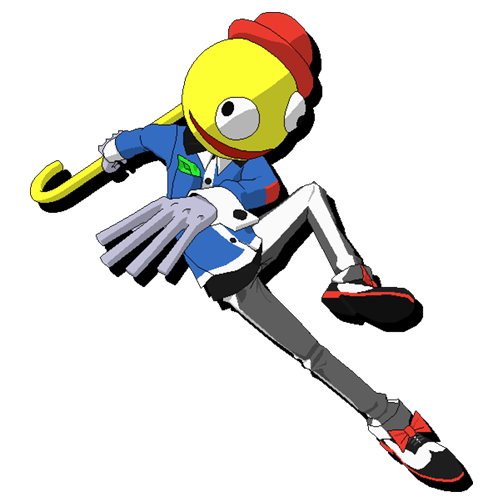
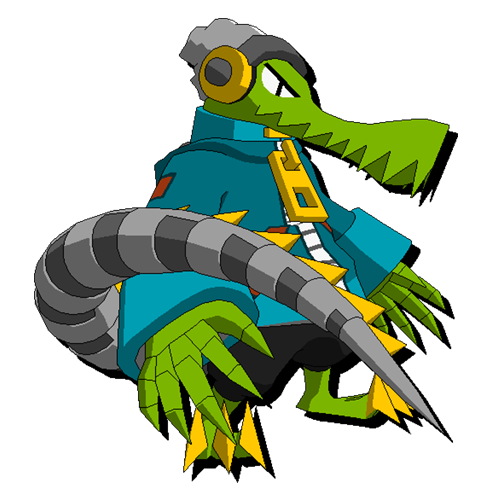
Another one of my personal favorites is obviously Burrito Bison, but I might be a little biased here ;)
The title also came during the jam, and our main focus back then was to make it sound catchy (4 successive syllables starting with “T”). It was also a reference to Toronto and ToJam. Toto.
By the time we finished the Ouya version, the title had already spread a bit on Google (articles, download sites, etc). We thought that Toto Temple was still catchy, so we decided to keep it and simply add Deluxe to make it distinct from the jam version.
Back then, we thought that “catchy” and easy to find on Google was enough for a good title. We never asked ourselves if it was suggesting the gameplay well enough, of anything else for that matter.
We received a lot of feedback regarding the Deluxe part saying that it had a strong “puzzle” feel to it, which was misleading. At first I was a little bit sceptical, but a quick search on Steam revealed that it might lead to confusion for some users.
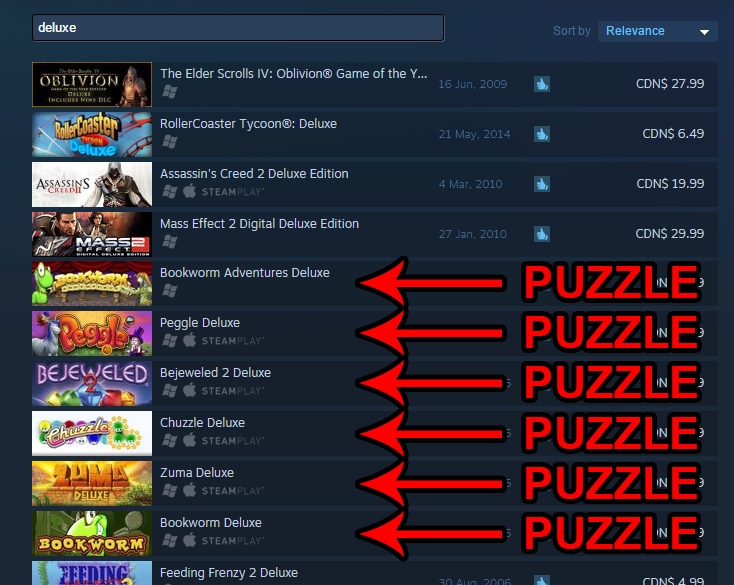
The title itself isn’t responsible for the poor sales, but it certainly played a role in the whole thing, being one of the first things people see (usually).
I like to think that both trailers are good. They’re not perfect, but they’re good. Again, I might be biased here because I made them myself.
The first one that came out, the Goat Interview, was supposed to teach viewers about the game’s mechanics. We wanted to do something like this because we felt like the gameplay was super chaotic and hard to understand just by looking at it.
The trailer is a bit too long, but as first my first attempt at writing a script ever, I still think that it wasn’t that bad. We were also in the process of getting more powerful computers at the time, so the gameplay footage isn’t exactly smooth either.
The second trailer that came out was the “official” gameplay trailer, where you can see how crazy Toto Temple Deluxe is. In a perfect world, you would have watched the first one before watching this one. That way, you’d understand what was going on.
I might still look like pure chaos in there, but I took particular care to teach important elements in the right order. In other words, the trailers talks to you the whole time. Here’s what it’s telling you:
[0:03] This game is about a goat
[0:05] You can play up to 4 players
[0:06] The goal is to “Get The Goat”
[0:09] It’s a good game (a bunch of laurels)
[0:10] You get the goat by dashing in the carrier
[0:11] Again in slow motion to make sure you really saw what happened
[0:12] You can block your opponents to keep the goat
[0:13] Again in slow motion
[0:17] The temples have traps in them, you’ll need to handle that
[0:19] Underwater, the game has very different temples
[0:22] Special boxes, what’s that?
[0:24] It’s a flaming goat, so there’s multiple types of goats (modes)
[0:28] We don’t take ourselves too seriously
[0:32] BOOM! Oh, it was a bomb goat!
[0:35] The game has teleporters, you can use them to trick/kill your opponents
[0:37] Again in slow motion
[0:38] You know everything now, we unleash the chaos and blow your mind
[0:41] Oh, we forgot, crazy power-ups too
[0:53] It’s called Toto Temple Deluxe, available here and here and there and...
Everything’s going SUPER fast, and you might not get everything in one view, but at least it’s the idea. I used a lot of repetition and slow motion to help you catch all the details, but even that wasn’t enough to clearly see everything. By the way, if you want to hear more about “making good trailers”, I suggest you read this great article by Kert Gartner.
Another point that could have helped selling the game to local-multiplayer aficionados is including live action footage of actual players enjoying the game (like this). This way, you really get an idea of what the game is about and how it is best played. A good example of that is the Sportsfriends trailer by Die Gute Fabrik.
Once again, not a deal breaker to omit this kind of footage, but it can definitely help sell the game to the right crowd.
We tend to do everything in-house (contacting media, official websites, video trailers, community management, etc). We’ve never been fans of spending money on marketing for things we could do ourselves. We also try to come up with creative solutions to market our games to counter-balance our low marketing budgets.
For Toto Temple Deluxe, we really tried to do more than what we usually do. We went to PAX for the first time (remember, we used to make Flash games), and we also paid for PR for the first time as well. While going to gaming events and paying for PR services is pretty traditional, we also experimented a bit with other things like real goats and automatic Twitch raffles.
Our first experience with PR wasn’t super useful in the end, to be honest. Even if we managed to get those services for a reasonable price (being “new customers” to a super friendly PR company), the end results left us pretty unsatisfied.
The services they provided were good, don’t get me wrong. We managed to get a couple interesting meetings scheduled at PAX (big websites), but the snowstorm that happened that week made some of them cancel. When we got back, the PR company helped us reschedule new online meetings with the sites who canceled, but none of them answered our multiple emails.
One other big website that actually came to the meeting wrote an article about the upcoming game following the event, but they never bothered writing a review once the game released. We contacted them multiple time with no luck, which is weird, considering they already showed an interest in the game.
We already wrote a detailed overview of this experiment, which you can read in full here.
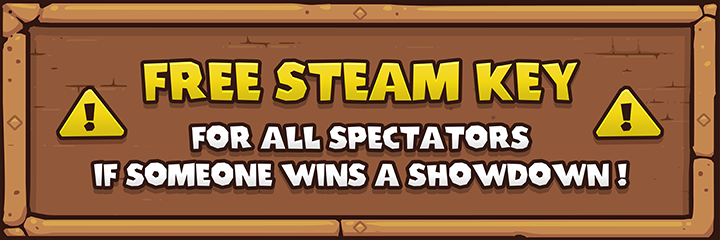
This particular experiment (the showdown system) was really successful at the event. We attracted big crowds and got noticed by a lot of players. The only problem is that we didn’t get noticed by that much press,which would have helped promote the game later down the road.
The showdown system worked so well with player though, that we replicated it at future events (like the Montreal Comiccon), and received the same type of response (only on a smaller scale). It’s definitely something we would try to adapt to our future games, and we encourage anyone to remix this idea to fit their needs.
When the game came out, we had a plan to join a good cause by promoting the Oxfam Unwrapped program. Oxfam are offering to buy real animals (like chickens, goats, donkeys, etc), to provide communities in need around the world. It’s a sort of donation, basically.

What we did is we committed ourselves to buy real goats in the name of anyone who would purchase the Real Goat bundle. The buyers would also get 4 copies (Steam keys) for Toto Temple Deluxe to share with their friends.
Despite being really well adapted to the theme of the game (goats) and being original to some extent, the Real Goat bundle didn’t sell at all. We think it’s probably due to 3 factors:
The steep price of the bundle ($60 USD), which basically just covers the price of the goat. We make no money with the bundle, which actually fits the “good cause” idea. We’re giving away copies of our game in exchange for a donation to a charity organisation.
We only felt comfortable giving away PC versions of the game. The game is more enjoyable / popular on consoles, but we’re not allowed to distribute console codes that way.
The game doesn’t support online-multiplayer, so 4 copies of a local-multiplayer game might feel less interesting a deal if it doesn’t let you play with your friends online. We were aiming to give buyers an opportunity to simply gift the game to their friends, but we completely understand the ambiguity.
Following the release of Toto Temple Deluxe, we organized a 1 day Twitch event called Bot Bet Battle.
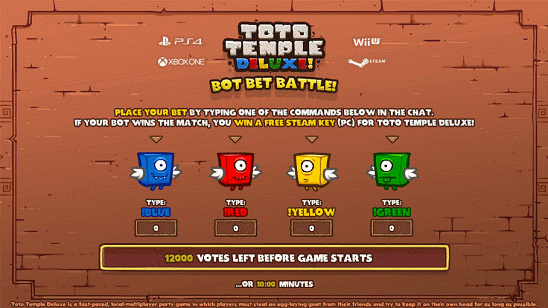
We had the game’s bots fight themselves in a classic tournament, and viewers could vote for the bot they thought would win. Everything was AI controlled, so we had no input over which bot would win.
The number votes would update in real time (or almost), the names of the voters would pop on the screen for everyone to see, and the tournament would start when enough votes were entered to fill the “votes bar”.

At the end of the tournament, everyone who voted for the winning bot would automatically receive Steam key in the chat system (as a whisper, obviously). You basically had a chance out of 4 to win a free copy of the game.
We would also ramp up the amount of necessary votes from round to round, so that viewers would invite their friends to accelerate the process.
We gave away about 1,400 Steam keys during the event. Knowing that a single account couldn’t win twice, and that a lot of viewers never won a key, we know we reached a lot more than 1,400 viewers.
We promoted the event on our social pages and a bunch of related subreddits, so there was probably a decent percentage of “new customers” in the lot.
Even though the event was fun, and that we probably managed to reach new followers, we barely noticed any bump in the game’s sales.
This one took us a lot of time and grew out of proportion pretty quickly. When we started working on the Deluxe version, we knew we wanted to include cameos from other games as a replacement for the goat (what you’re fighting for). By other games, we mean games made by friends of ours and other developers we admire and respect.We also wanted to include people in there (not just game characters), like the developers themselves.
All of this was supposed to be a small and cute addition to the game. We were adding unlockable cameos from games we love, and everyone from the team started to pitch in. This is where everything exploded. We created around 150 cameos (and by we I mean JP, our artist), ranging from game characters to their developers themselves. Here’s some examples:




We reached out to every single developer to introduce our idea and get an approval if they liked it. Some of them were already our friends, which was easy, but a lot of them were big developers we never spoke with before. Sometimes it took a lot of effort / contacts to get the missing email addresses.
We wanted to do things in a clean way, so we wrote a personalized agreement for each of them, stating that the cameos were just cosmetic additions, and that we would never sell them or make money directly from them, etc.
The agreement itself let the devs change the name of the cameos, decide on which consoles they would appear, pick the secret code to unlock them, and if they agreed with the whole idea or not. A digital signature was required, and boom, everything was set (no PDF, no emails).
A couple months later, on the actual release date, we’ve seen a lot of those devs share their cameos (and their secret code to unlock them) on Twitter and Facebook. Not all of them shared though. There was obviously no way to predict who would share and who wouldn’t, but we still saw a LOT of tweets that day.
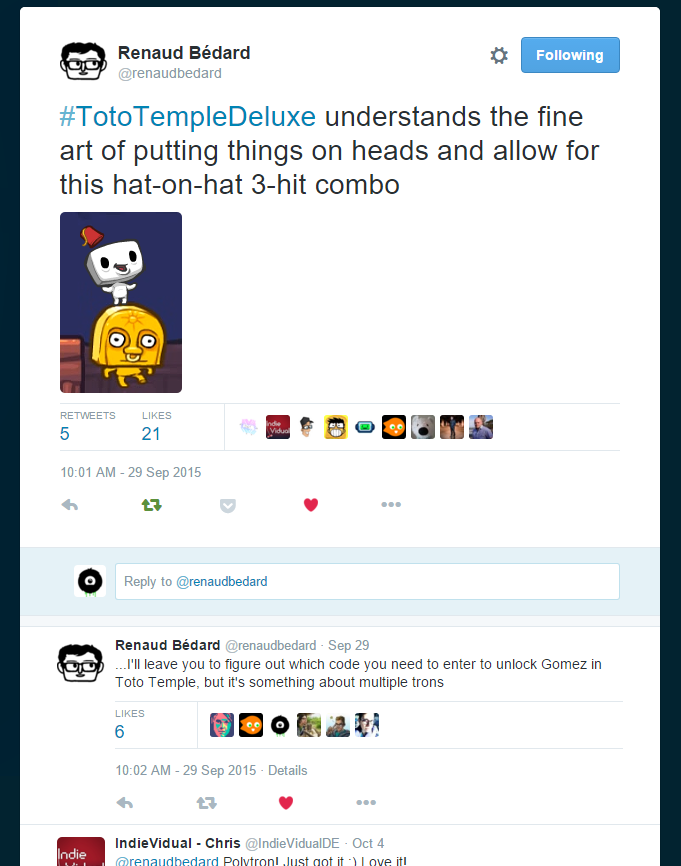
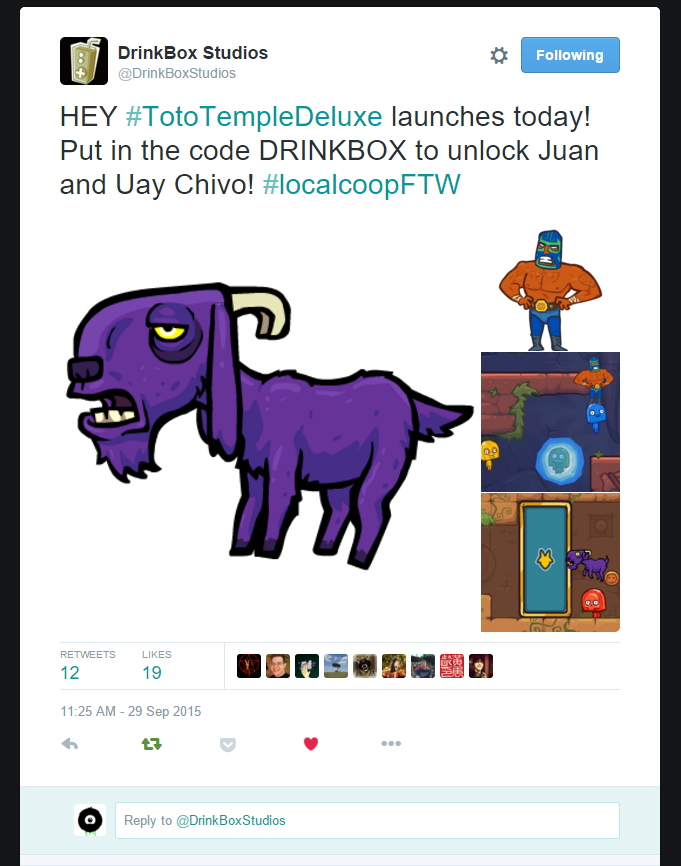
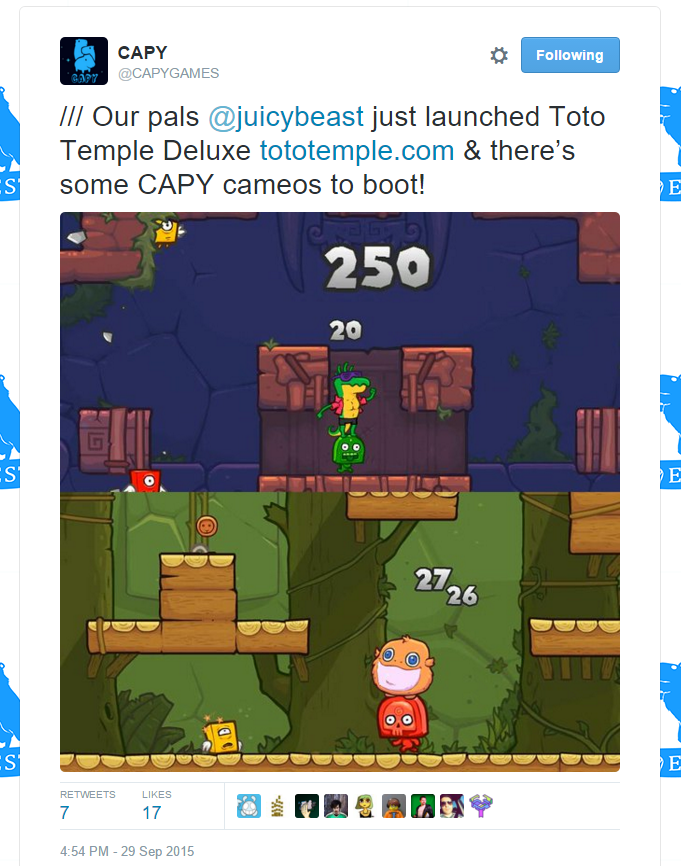
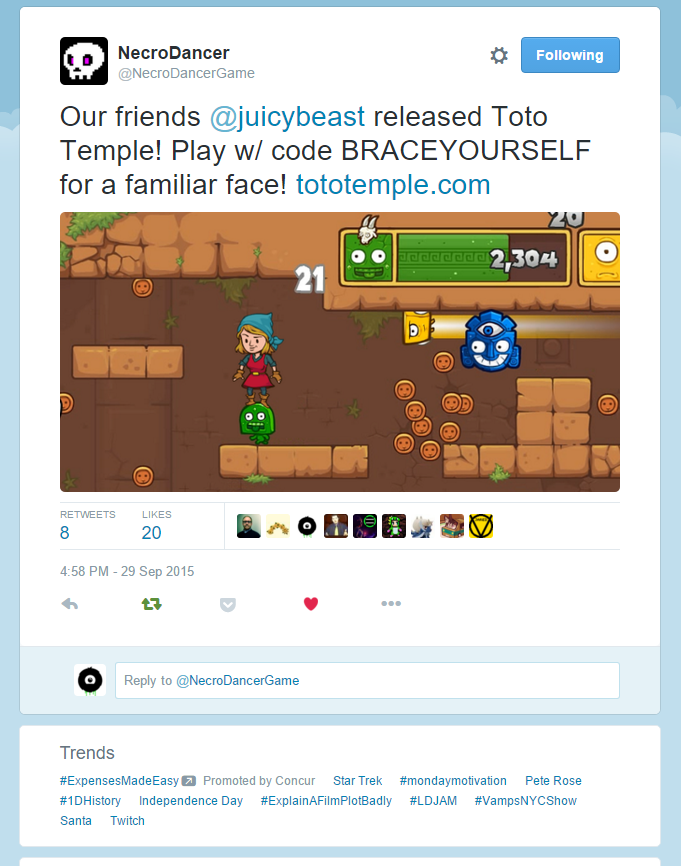
It’s pretty hard to calculate how much visibility we gained through the cameo system, as we can’t access other dev’s Twitter stats, but we probably reached a lot of people who wouldn’t have been aware of the game otherwise. What we can calculate though, is how many new connections we made with developers we admire, and we’re pretty happy about it <3
A newsletter system is nothing new, but we also toyed with it for the first time. Okay, maybe the second time. Remember that part where we gave out free Steam keys at events? Well they weren’t really free. We actually asked people to subscribe to our newsletter in order to receive the key. You can get all the details about how we did it here.
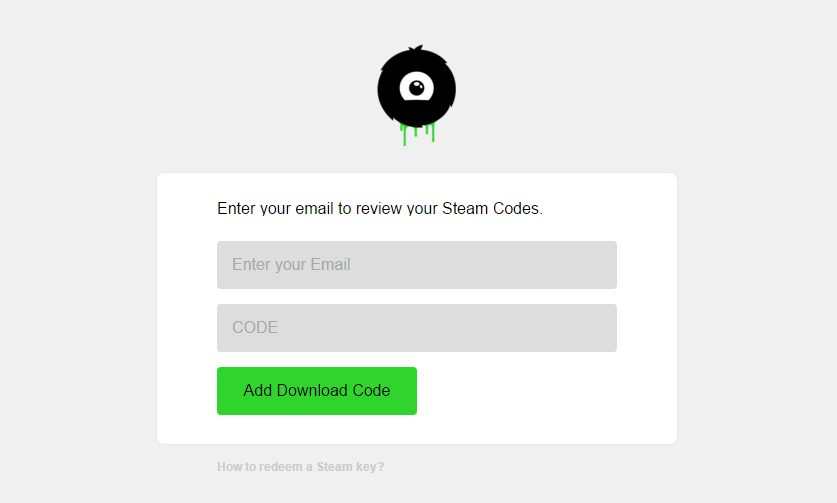
We even created a sweet little backend system (with the help of our good friend Devine Lu Linvega) that automatically distribute the keys without having us send a single email. We just need to upload the keys to a database, and the system handles everything.
Users need a unique code printed on the “key card” they won
They join our newsletter by entering their email address and unique code in a Mailchimp form
Mailchimp sends the info back to our backend system, where we validate the code and register the email if it’s good
Users automatically receive an email with their key in it
We managed to gather 1,437 email addresses around Toto Temple Deluxe (not just with free keys), which all received a single email on the release date (we don’t like spam). Out of these 1,437 emails we sent, 493 (34%) were opened, and 72 (5%) got clicked. Based on certain benchmarks, these numbers aren’t that bad!
The game was fun and players were genuinely engaged at events. We reached out to a lot of press with the help of a PR company, but barely got any coverage. We tried different and original marketing tactics, but they didn’t resulted in many changes in the sales. So, what happened?
There’s a good possibility that the game didn’t have good enough “hooks” to captivate people’s attention. Sure, “fighting your friends to put an egg-laying goat on your head” sounds funny and weird, but it doesn’t really give you a clear idea of what it’s like to play Toto Temple Deluxe.
At the end of the day, we think the biggest factor is because it’s a local-multiplayer game with no online play. The game is aiming at a pretty niche audience by requiring actual human friends to play, and we can’t ignore the impact it has on sales. A quick look at comments on YouTube, Reddit and such, and it’s obvious that a lot of people are simply not buying the game for this very reason (that along a lack of solo experience). Here’s one example:
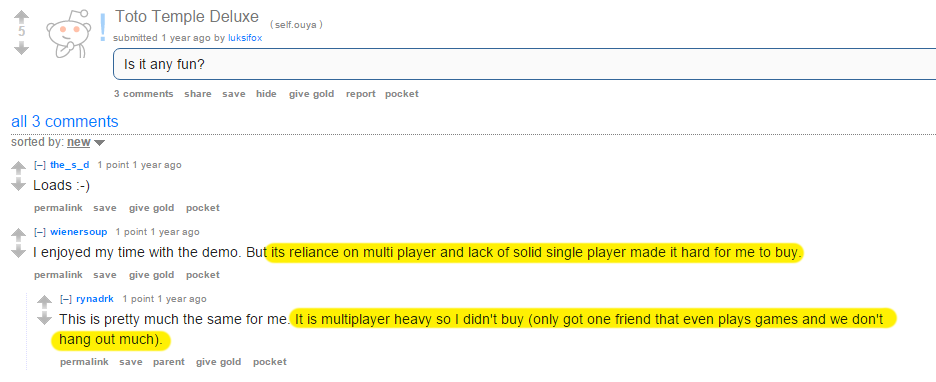
To confirm this idea, one of our contacts from a very well known gaming site explained to us why they wouldn’t write an article on Toto Temple Deluxe. Apparently, it’s simply because local-multiplayer news don’t generate enough clicks to be worth it. We totally appreciated the honesty!
On top of all this, we also think the game came out almost 2 years too late. Back in 2014, when the local-multiplayer boom was happening, Toto Temple Deluxe’s development felt more logical. Today, it feels a bit out of place, as we think a lot of player might have bought popular local-multiplayer games in the past, then realised that they would play them less and less frequently. We definitely can’t blame them, since it’s pretty much the same for us.
Obviously, these are all based on our current knowledge and experience, and probably doesn’t apply to all local-multiplayer games. If you’re reading this and you’re thinking we missed a point, or have a different opinion on the subject, we’d love to hear it!
Releasing the game on the 3 consoles at the same time felt like a good idea at the time. We were only thinking about it from a revenues and media coverage standpoint, which was obviously a big mistake (for a local-multiplayer game released 2 years too late with no online mode, at least).
The worst part in all of this is probably that our only programmer, Alex, did all the heavy lifting by himself (the guy’s a freaking machine). Making the game run smoothly on all 3 consoles took him a good amount of time and energy, especially during the certification process.
To give you an idea of the difference between the 3 consoles, here’s how we spent our time on the actual ports over the second year of development:
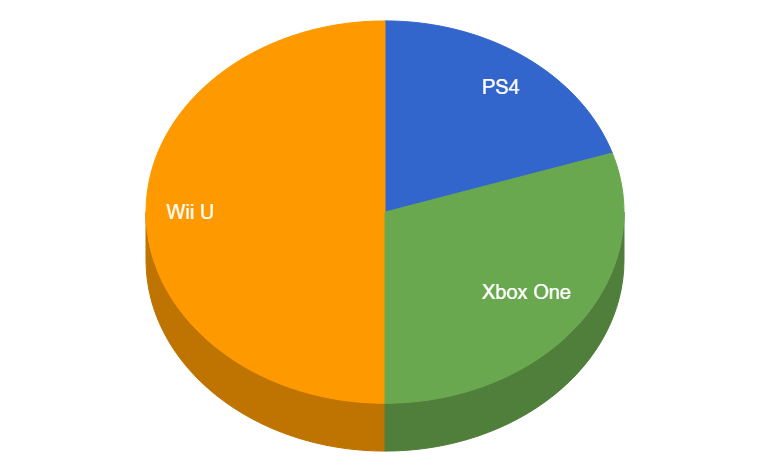
Considering that we made about equal revenues on each consoles so far, you can see that one was definitely more expensive to port to. This might change in the future though, as this was our very first time working with consoles. We also received a lot of help from our friends from Chainsawesome Games for the Xbox One port, which saved us a lot of time and headaches!
Another factor that greatly extended the port process was having to jump back and forth between the different versions of the game. Yes, Unity makes it easier to port to multiple platforms, but the requirements for each console were so different that we ended up having 3 different Unity projects / branches to support them.

We lost a LOT of time patching little mistakes here and there, like details we added or fixed on one version but forgot to include in the other, etc. With only 2 team members skilled enough to handle the “technical stuff”, you can surely imagine how this inefficient workflow became extremely messy during the certification process.
We mentioned that most of the ports were handled by Alex, our programmer, with a lot of additional help from Dom (certs, store metadata, etc), so a Reddit user asked “what were the artists/other non-programmers doing during that time?”
It’s a totally legit question, considering I didn’t cover it much in the article. As you already read above, JP, our artist, handled all the cameos. He drew around 150 in total, with a lot of them being “caricatures” of real people (kind of harder to draw). I was overseeing the whole cameo thing with Dom, but I was also in charge the 2 trailers.
My answer on Reddit:
"We made our 2 trailers in house, and one of them was a frame by frame animation / cartoon with scripting and voice acting. We also needed to render, submit and rate both trailers, for 3 companies, split in 2 continents (American and European divisions are all separate entities), which all have different requirements depending if it's a storefront video or a website video, or a YT channel video, etc.
Each company has a required set of video encoding setting that differs based on what I just listed, and we're not even talking about legal lines at the end of trailers, rating icons (ESRB, PEGI), console logo placement / colors / size requirements (because that’s a thing). Here's a screenshot of the list of all the different renders we made for just 2 simple trailers.
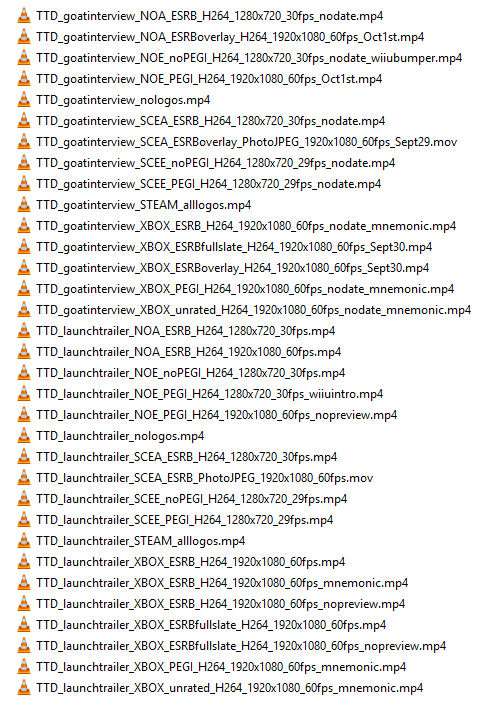
A lot of that year was spent f*cking up and trying to fix things. Big AAA companies usually have complete departments dealing with certs and all that kind of stuff, they're used to it and they know what they're doing. We don't ;)"
Obviously, the rendering of all these videos is nothing compared to 3 actual ports, but if you’re thinking about doing it yourself, it's useful to know that it might take you more time than expected.
We spent 2 years, full time, working on Toto Temple Deluxe. The first year was about developing the game and its content, while the second year was about porting it to 3 different consoles at once. That second year is where we started to feel the burn.
We’re a team of creative people, and we get our motivation and energy by exploiting that creativity. We like to create things, invent worlds and mechanics. That second year of development was all about paperwork, unusable console portals, technical problems, bugs and desperate searches for information (consoles and their documentation are not really easy to navigate).

Once we shipped the game on Sept 29th, we all went home and did nothing for a least a week. Porting Toto Temple Deluxe really drained us out, especially for Alex who did a inhuman job all by himself (seriously, a machine).
The process of porting the game was hard by itself, but following up a year of non-creative work with a launch that doesn’t make much noise, nor sell a lot, was pretty hard on all of us. We’re slowly getting back in shape for a new project (winning the prize of the most addicting game with Right Click to Necromance for Indie Speed Run shook things up a bit), but we can still taste the bitterness of the unsuccessful launch.
Back in the days, when we were young and naive, we pictured console storefronts as big marketing machines with lots of users and traffic (remember, we were doing Flash games). We realized pretty quickly that it’s not how it works!
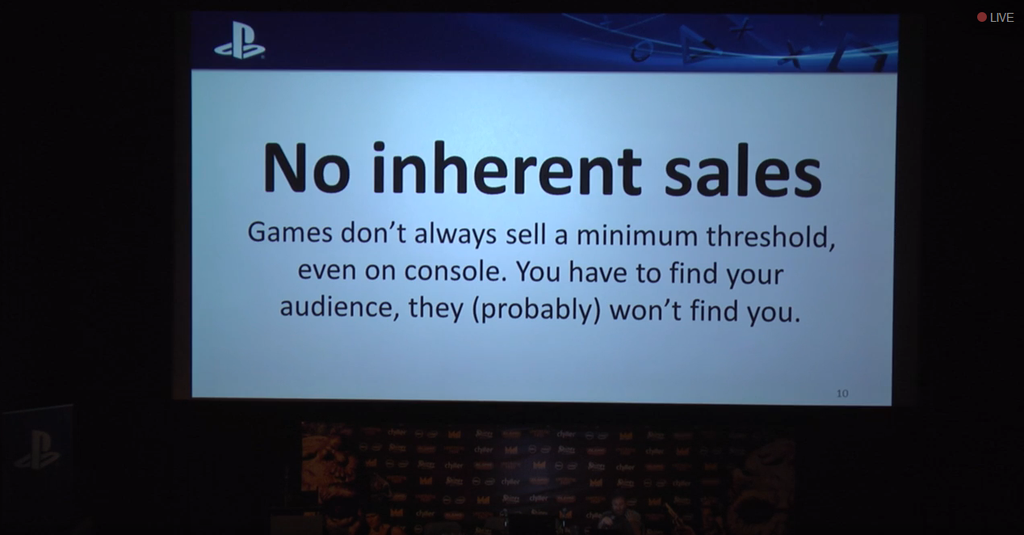
Since we couldn’t really strike an exclusivity deal with any of the consoles, with the Ouya version already available, and we were porting to all 3 consoles at the same time (no “semi-exclusivity”), Toto Temple Deluxe probably wasn’t perceived as a really interesting deal for any of the consoles. Sure, they were getting a new game for their system, but that was pretty much it.
Because of that, we weren’t really able to get a featured spot on any the storefronts, except for Nintendo who actually featured us on both the American and European front pages. Thanks Nintendo!

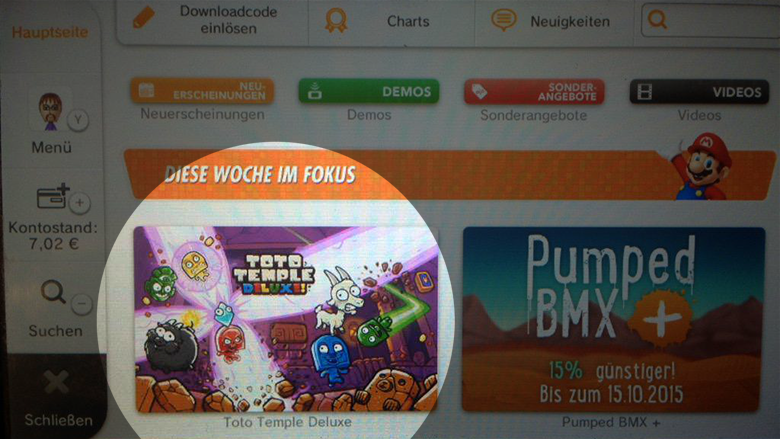
What’s also interesting is that being featured twice on the Wii U eShop actually ramped up the sales of the game to almost equal numbers with the other 2.
We’ve learned a lot with Toto Temple Deluxe, and there’s a lot of things we’d do differently (or not at all) for our next game:
No more local-multiplayer
They’re easy to make in a game jam, but super hard to market if you don’t add online play.
Strike a deal first
If we’re to make another game on console, we’ll make sure to strike an exclusivity deal first, so we can get a bit more help and visibility from the console owner.
Only one console
It goes without saying that with we’ll only do one console if we strike an exclusivity deal, but even without that, we wouldn’t port to 3 consoles at once ever again. It’s a LOT of hard work that didn’t really paid well in the end.
Design from a marketing perspective
Visibility is getting harder and harder to come by, so we’ll try to design our games with marketing in mind from day one. Having a solid hook and making sure there’s a potential audience for your game is super important. I suggest you read this great article on the subject by Ryan Clark from Brace Yourself.
I think it’s easy to think of Toto Temple Deluxe as a failure. Even worst, a waste of time and resources. Sure, the game only generated a fraction of what we spent on it, but we’ve learned a lot. Now it’s time to get up, dust off our shoulders and get the creative juice flowing again!
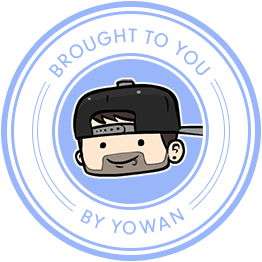
Read more about:
Featured BlogsYou May Also Like